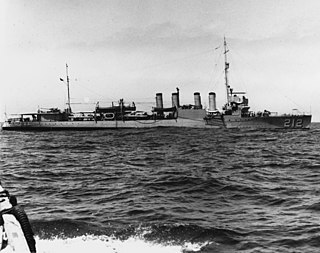
The Great White Fleet was the popular nickname for the group of United States Navy battleships which completed a journey around the globe from December 16, 1907 to February 22, 1909 by order of President Theodore Roosevelt. Its mission was to make friendly courtesy visits to numerous countries while displaying new U.S. naval power to the world. One goal was to deter a threatened war with Japan since tensions were high in 1907. It familiarized the 14,500 officers and men with the logistical and planning needs for extended fleet action far from home. Hulls were painted a stark white, giving the armada its nickname. It consisted of 16 battleships divided into two squadrons, along with various small escorts. Roosevelt sought to demonstrate growing American military power and blue-water navy capability. After long neglecting the Navy, Congress started generous appropriations in the late 1880s. Beginning with just 90 small ships, over one-third of them wooden and obsolete, the navy quickly added new steel fighting vessels. The fleet's capital ships were already obsolete compared to the British dreadnoughts in 1907. Nevertheless, it was by far the largest and most powerful fleet that had ever circled the globe. The mission was a success at home and in every country it visited, as well as Europe.

USS Nimitz (CVN-68) is an aircraft carrier of the United States Navy, and the lead ship of her class. One of the largest warships in the world, she was laid down, launched, and commissioned as CVAN-68, "aircraft carrier, attack, nuclear powered", but she was later redesignated as CVN-68, "aircraft carrier, multi-mission, nuclear-powered", on 30 June 1975, as part of a fleet-wide realignment that year.

The Sixth Fleet is a numbered fleet of the United States Navy operating as part of United States Naval Forces Europe. The Sixth Fleet is headquartered at Naval Support Activity Naples, Italy. The officially stated mission of the Sixth Fleet in 2011 is that it "conducts the full range of Maritime Operations and Theater Security Cooperation missions, in concert with coalition, joint, interagency, and other parties, in order to advance security and stability in Europe and Africa." The current commander of the Sixth Fleet is Vice Admiral Eugene H. Black III.

The Russian Navy is the naval arm of the Russian Armed Forces. It has existed in various forms since 1696; its present iteration was formed in January 1992 when it succeeded the Navy of the Commonwealth of Independent States.

Admiral Mikhail Petrovich Lazarev was a Russian fleet commander and an explorer.

The British Mediterranean Fleet, also known as the Mediterranean Station, was a formation of the Royal Navy. The Fleet was one of the most prestigious commands in the navy for the majority of its history, defending the vital sea link between the United Kingdom and the majority of the British Empire in the Eastern Hemisphere. The first Commander-in-Chief for the Mediterranean Fleet was the appointment of General at Sea Robert Blake in September 1654. The Fleet was in existence until 1967.

USS Key West (SSN-722), a Los Angeles-class submarine, is the third ship of the United States Navy to be named after Key West, Florida.

The Strike Fighter Squadron 14 (VFA-14) "Tophatters" are a United States Navy fighter attack squadron based at Naval Air Station Lemoore. They fly the F/A-18E Super Hornet, and are the Navy's oldest active squadron, having formed in 1919. Their callsign is Camelot, and their tail code is NG.

USS Guerriere was the first frigate built in the United States since 1801. The name came from a fast 38-gun British frigate captured and destroyed in a half-hour battle by USS Constitution on 19 August 1812. This victory was one of the United States' first in the War of 1812.

The Baltic Fleet is the fleet of the Russian Navy in the Baltic Sea.

USS Smith Thompson (DD-212) was a Clemson-class destroyer in service with the United States Navy from 1919 to 1936. She was intentionally sunk following a collision with USS Whipple (DD-217), in July 1936.

Strike Fighter Squadron 137 (VFA-137), also known as the "Kestrels", are a United States Navy F/A-18E Super Hornet strike fighter squadron stationed at Naval Air Station Lemoore, California. Their radio callsign is "Falcon".

Strike Fighter Squadron 34 (VFA-34), also known as the "Blue Blasters", is a United States Navy F/A-18E Super Hornet strike fighter squadron stationed at Naval Air Station Oceana. They are a part of Carrier Air Wing 1 and are attached to the aircraft carrier USS Harry S. Truman. Their tail code is AB and their radio call sign is "Joker".

Strike Fighter Squadron 105 (VFA-105) also known as the "Gunslingers" is a United States Navy strike fighter squadron based at Naval Air Station Oceana, Virginia. The "Gunslingers" are an operational fleet squadron and fly the F/A-18E Super Hornet. Their radio callsign is "Canyon" and the tail code is AC.

Fleet Logistics Support Squadron 40 (VRC-40), also known as the "Rawhides", is a United States Navy fleet logistics support squadron based at NS Norfolk. Commissioned in 1960, it is one of only two active fleet logistics squadrons in the Navy, the other being VRC-30.

Aegean Sea anti-piracy operations began in 1825 when the United States government dispatched a squadron of ships to suppress Greek piracy in the Aegean Sea. The Greek civil wars of 1824–1825 and the decline of the Hellenic Navy made the Aegean quickly become a haven for pirates who sometimes doubled as privateers.

The Pacific Fleet is the Russian Navy fleet in the Pacific Ocean.

Destroyer Squadron 60 is a destroyer squadron of the United States Navy. Destroyer Squadron 60 is one of three U.S. Navy destroyer squadrons permanently based outside the continental United States.

















